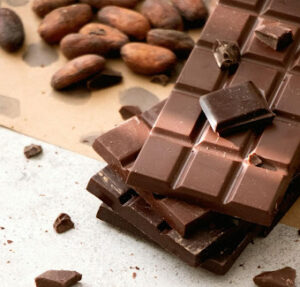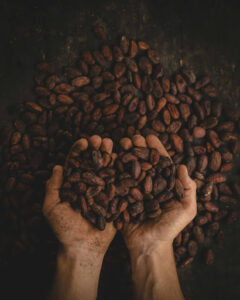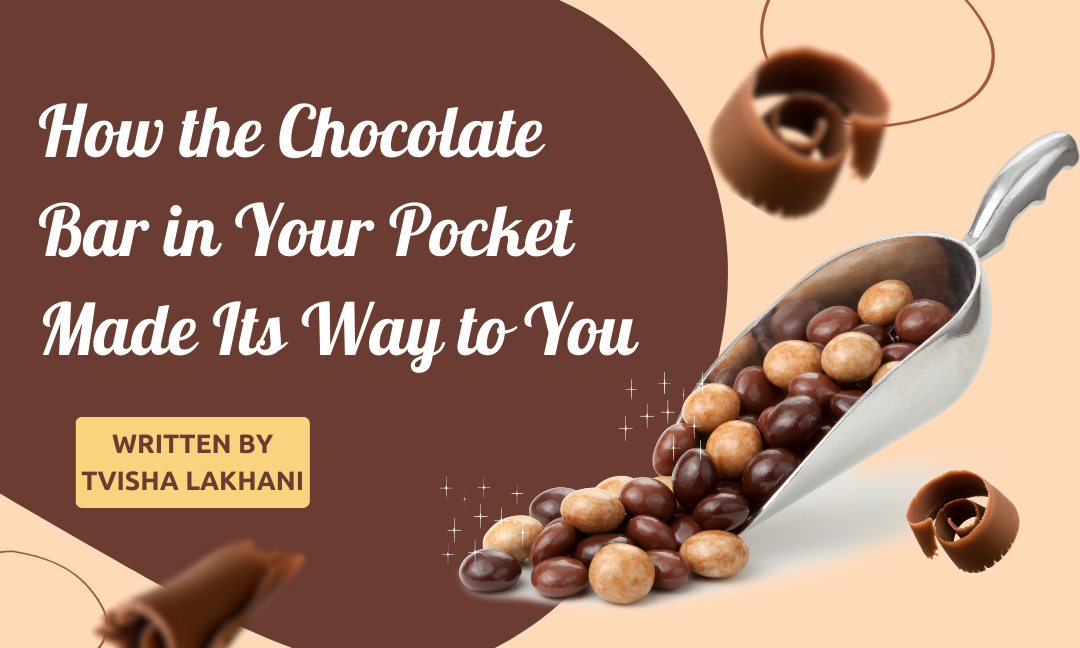Written by Tvisha Lakhani
Edited by Kiritika Rana
Designed by Kiritika Rana
Published by Kiritika Rana

You’re doing the next round in the never-ending cycle called your laundry when you find something in the pocket of your jeans. It’s a chocolate bar, half-melted and rehardened into a misshapen shape. You wonder, how did that get here? Well, let’s find out!
Today, the top producers of cocoa beans are Cote d’Ivoire and Ghana, both in Africa, but before, chocolate originally came from Latin America.
Many ancient civilizations have used chocolate: the Olmecs, the Mayans, and the Aztecs. The Olmecs were the first civilization to experiment with chocolate, and as time went on, other civilizations did the same. In the Mayan civilization, chocolate was drunk as a beverage in most households, often flavoured with chilli or honey. Xocolatl, as it was called by the Aztecs, was a revered drink and the cocoa beans used to make it were even used as currency.
While there are several stories on how it happened, chocolate eventually made its way to Spain in the 1500s. Over time, chocolate came to other parts of Europe as well and this European chocolate tended to be sweeter than its Aztec counterparts. To meet the growing popularity of chocolate, chocolate plantations were established in equatorial regions by many countries, and many enslaved were forced to work on these plantations.
Even today, practices like child labour can still be seen on chocolate plantations, although many measures are being taken to stop it. As time went on, many advancements in chocolate-making technology followed. New processes and machines were invented for better quality and faster production of chocolate. The cocoa press was a particularly big milestone in the history of chocolate.
It separated cocoa butter from roasted cocoa beans, and this process left behind cocoa powder. Advancements such as these increased the affordability of chocolate and the ability to mass produce it.
The first solid chocolate was made by J.S. Fry and Sons in 1847. Almost three decades later, a man named Daniel Peter made the first milk chocolate by adding dried milk powder to it.
In the past century and a bit, chocolate and its production have evolved substantially. But that raises the question, how is chocolate made today?

1. Growing and harvesting cacao beans
Cacao beans are harvested from pods that grow on cacao trees. These trees are generally grown near the equator in hot and humid areas. Pods can contain up to 50 beans. When the pods ripen to a bright orange-yellow, they are harvested, usually twice a year.
2. Fermenting the beans
Once the cacao beans are cleaned (with some of the pod’s pulp remaining for flavour), they are fermented. Different areas of the world do this differently; for example, parts of Africa often let the beans ferment in piles on the ground while parts of Latin America do the fermentation process in specific boxes. The fermentation process usually takes 2 to 9 days.
 3. Drying the beans
3. Drying the beans
Cacao beans are then dried under the sun, often being moved and turned around to dry them consistently. These beans are then
4. Roasting the beans and making cocoa mass
The beans are roasted to enhance the flavour and then winnowed, a process where the nibs and shells are separated. By grinding the nibs, cocoa mass is produced. This cocoa mass can be pressurized further, turning it into cocoa powder and cocoa butter.
5. Making chocolate
Different types of chocolate use different basic ingredients. Milk chocolate uses cocoa mass, cocoa butter, sugar, and milk powder. Omit the milk powder, and you have the basic ingredients for dark chocolate. Omit the cocoa mass instead, and you have the basic ingredients for white chocolate. Whichever ingredients are used, they are mixed into a paste.
6. Conching the chocolate
The chocolate is put through the process of conching, where it is put into a conch and slowly mixed around and heated evenly. This process immensely increases the smoothness of chocolate.
7. Tempering the chocolate
The chocolate is tempered, a process that requires slowly heating it. Tempering helps make chocolate smoother, and shinier and improves its texture as well. This tempered chocolate is then put into molds to harden.
8. Eating!
After making its way through the rest of the supply chain, this chocolate ends up with you! What will you do with it?
Resources:
- https://www.magnumicecream.com/ca/en/stories/food/the-history-of-chocolate.html
- https://www.history.com/topics/ancient-americas/history-of-chocolate
- https://www.lakechamplainchocolates.com/making-chocolate/
- https://www.kakaoplattform.ch/about-cocoa/cocoa-facts-and-figures
- https://unsplash.com/photos/chocolate-bars-on-white-table-H22N-9s8AUw
- https://unsplash.com/photos/person-holding-dried-beans-SCbq6uKCyMY

